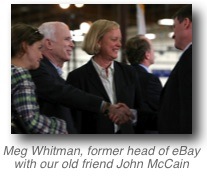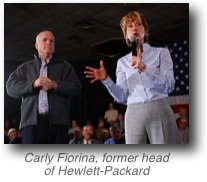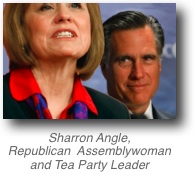The Rise of the Women
June 10, 2010 By Lou Cannon
Entering the tumultuous primary season, the respected political analyst Charlie Cook speculated that 2010 might be the year of the "angry white senior." Although there are certainly plenty of angry men around, the results of last Tuesday's primaries suggest that this may turn out to be the year of the angry (and determined) female Republican candidate.
In CALIFORNIA, where the GOP had never before put forward a woman for high statewide office, Republican voters nominated billionaire Meg Whitman, the former eBay chief executive, for governor, and Carly Fiorina, the former CEO of Hewlett-Packard for U.S. Senate. In NEVADA, underdog Sharron Angle, a Tea Party favorite, upset an establishment candidate, also a woman, in the GOP Senate primary. (Both of them outpolled a third, perfectly respectable, male candidate.) Angle will face Senate Majority Leader Harry Reid in November. Still another Tea Party favorite, Nikki Haley, overcame slurs against her virtue and ethnicity, to lead the Republican gubernatorial primary in SOUTH CAROLINA. Haley wiped the floor with a slew of male Republicans, falling just short of 50 percent, and will face second-place finisher Rep. Gresham Barrett in a June 22 runoff.
In NEVADA, underdog Sharron Angle, a Tea Party favorite, upset an establishment candidate, also a woman, in the GOP Senate primary. (Both of them outpolled a third, perfectly respectable, male candidate.) Angle will face Senate Majority Leader Harry Reid in November. Still another Tea Party favorite, Nikki Haley, overcame slurs against her virtue and ethnicity, to lead the Republican gubernatorial primary in SOUTH CAROLINA. Haley wiped the floor with a slew of male Republicans, falling just short of 50 percent, and will face second-place finisher Rep. Gresham Barrett in a June 22 runoff.
 Meanwhile, a Democratic woman had her day in ARKANSAS. Centrist Sen. Blanche Lincoln turned back a challenge in a Democratic primary runoff from liberal Lt. Gov. Bill Halter, who had been favored. Her victory gave heart to incumbents, who have been having a bad year in both parties. Lincoln survived attacks on her left from environmentalists over her closeness to oil companies, liberal activists who proclaimed she was insufficiently supportive of health care reform, and labor leaders furious with the senator's opposition to "card check," which would enable unions to be recognized as a bargaining unit without an election of the workers they seek to represent. Lincoln also weathered attacks from the business community, especially bankers that dislike her support for controlling the much-abused practice of derivatives in the financial reform bill now pending in Congress.
Meanwhile, a Democratic woman had her day in ARKANSAS. Centrist Sen. Blanche Lincoln turned back a challenge in a Democratic primary runoff from liberal Lt. Gov. Bill Halter, who had been favored. Her victory gave heart to incumbents, who have been having a bad year in both parties. Lincoln survived attacks on her left from environmentalists over her closeness to oil companies, liberal activists who proclaimed she was insufficiently supportive of health care reform, and labor leaders furious with the senator's opposition to "card check," which would enable unions to be recognized as a bargaining unit without an election of the workers they seek to represent. Lincoln also weathered attacks from the business community, especially bankers that dislike her support for controlling the much-abused practice of derivatives in the financial reform bill now pending in Congress.
 Politically, there are profound differences among the candidates who won Tuesday, but all are part of an ongoing trend that is bringing women into elective office at all levels of government. According to the National Conference of State Legislatures, there are currently 1,804 women legislators in the 50 states, 24.4 percent of the total. The percentage has increased slowly but steadily during the past two decades. The most dramatic recent change has been among Republican women seeking higher office, with 14 this year running for the U.S. Senate compared to only three in 2008. Seventeen women presently serve in the Senate; only four are Republicans. There are six women governors, evenly divided between the parties. Since both parties in NEW MEXICO have nominated women, that state will have a female governor for the first time.
Politically, there are profound differences among the candidates who won Tuesday, but all are part of an ongoing trend that is bringing women into elective office at all levels of government. According to the National Conference of State Legislatures, there are currently 1,804 women legislators in the 50 states, 24.4 percent of the total. The percentage has increased slowly but steadily during the past two decades. The most dramatic recent change has been among Republican women seeking higher office, with 14 this year running for the U.S. Senate compared to only three in 2008. Seventeen women presently serve in the Senate; only four are Republicans. There are six women governors, evenly divided between the parties. Since both parties in NEW MEXICO have nominated women, that state will have a female governor for the first time.
Some of the surge in Republican candidacies among women probably is attributable to the star power of Sarah Palin, the former ALASKA governor, who campaigned for Fiorina and Angle. Some of it may also be due to the related phenomenon of the populist Tea Party, whose candidates tend to be political unknowns. But the larger reason for the emergence of women in politics is their advance toward equality in many arenas of business and public life. "Women have come up in politics through state and local government," says Martha Joynt Kumar, a professor of political science at Towson State University in Maryland who is at work on a book about the presidential transition from George W. Bush to Barack Obama. "They started out as volunteers. Some of them went into the work place, seeking careers. In politics they were elected to lower offices and are now moving on to higher ones. It's a natural progression." Tim Storey, a political analyst for NCSL, agrees with this narrative, pointing out that several of the women who have run for governor and congressional office came up from the legislature, including Nikki Haley in SOUTH CAROLINA. "It took a long time to get women into the pipeline," said Storey, who notes that they are still "significantly under-represented" in legislatures and Congress.
Storey also believes that women have an added advantage in a year such as this when incumbency is toxic. "When people visualize a politician, they usually have a man in mind," Storey said. "Women epitomize the outsiders." And this is a good year for outsiders in gubernatorial elections. After this week's primaries in which incumbent Gov. Jim Gibbons of NEVADA lost in the GOP primary, at least 24 governors will be new in 2011. Several other incumbents are in trouble; Storey said the number of new governors could exceed the Depression-era record of 27.
Outsiders most certainly had the edge in the CALIFORNIA primary. In fact, Whitman and Fiorina are so far outside the normal political process that they have rarely voted, an issue for which they have been scorned in the media but that as of yet has had no discernible impact with voters. Both women, and especially Fiorina, face uphill general-election races in a state in which Democrats have a registration edge of a million and a half votes. CALIFORNIA has since 1992 been represented in the U.S. Senate by Dianne Feinstein and Barbara Boxer, both Democrats. Boxer, who in the past faced weak and under-funded Republican candidates, is seeking a fourth term. Fiorina is not weak and has plenty of money but faces the daunting task of making her first statewide race against a capable politician who has run sharply honed campaigns in the past. Fiorina started out as a moderate but moved right in the campaign to pose as the "true conservative" against two male candidates, one to the left of Fiorina and the other to the right. Democrats will do their best to hinder Fiorina's expected scramble back to the political center, where most elections are won or lost in CALIFORNIA.
Whitman, a billionaire, spent $81 million, much of it her own money, to win the gubernatorial nomination against Insurance Commissioner Steve Poizner and is prepared to spend whatever it takes in the fall campaign. She also moved right in the primary campaign but less so than Fiorina. "Whitman only muddied the waters in her positions on abortion and immigration," observes Bill Carrick, a well-known Democratic political consultant who is not involved in the Brown or Boxer campaigns. "Carly went hard-right and will find it harder to get back to acceptable positions." As an example, Whitman favors public funding of abortions, which Fiorina opposes. No pro-life candidate has won a statewide CALIFORNIA race in two decades.
In the November election Whitman will face State Attorney General Jerry Brown, a two-term governor of CALIFORNIA from 1975-83, and the son of a former governor, the late Pat Brown. On the face of it, Brown, who also served two terms as mayor of Oakland, is the ultimate insider, but he always seemed a bit outside the system even when he was governor. Brown earned the sobriquet (from Chicago Tribune columnist Mike Royko) as "Governor Moonbeam," for his unusual advocacies, including a CALIFORNIA space station. He was, however, a visionary governor on environmental and energy issues. Brown has now developed a pardonable pride in the "Moonbeam" label, which he referred to at a victory party after being nominated against token opposition.
So far, however, neither Brown nor Whitman has put forth a plan for ending the legislative gridlock and solving the perpetual budget shortfall in Sacramento. Charlie Cooke calls the race a toss-up. Whether it will also be another chapter in this year of Republican women remains to be seen.
return to the Legislative page
Pennsylvania Federation BMWED-IBT